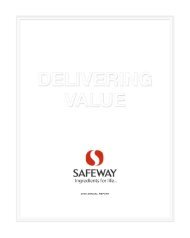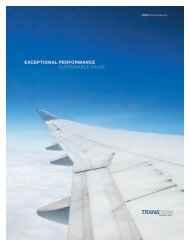Bemis Company 2007 Annual Report - IR Solutions
Bemis Company 2007 Annual Report - IR Solutions
Bemis Company 2007 Annual Report - IR Solutions
You also want an ePaper? Increase the reach of your titles
YUMPU automatically turns print PDFs into web optimized ePapers that Google loves.
In 1900, in order to secure a dependable supply of high-quality cotton for use<br />
in bag production, <strong>Bemis</strong> Bro. Bag Co. bought a 300-acre site near Jackson,<br />
Tennessee. The site became the town of <strong>Bemis</strong>, the bag company’s first company<br />
town. Judson Moss <strong>Bemis</strong>’ son, Albert Farwell <strong>Bemis</strong>, took an active<br />
roll in designing <strong>Bemis</strong>, Tennessee to provide employees with all<br />
the necessities of life at the turn of the century like schools,<br />
churches, shops, and even a YMCA. The town also boasted<br />
luxuries like wide, tree-lined streets, sizable homes, and<br />
ample space for sports and community events. By the<br />
time it celebrated its 50th anniversary in 1950, the<br />
town’s population had reached 4,000, and more than<br />
a quarter of the inhabitants were employed at the<br />
<strong>Bemis</strong> mill. <strong>Bemis</strong> operated the Jackson Fibre Department<br />
and Cotton Mill in Tennessee until 1980.<br />
<strong>Bemis</strong> Bro. Bag <strong>Company</strong> continued to expand and develop new products<br />
throughout the early decades of the twentieth century. In 1913, the company<br />
opened its first paper mill and plant as paper bags gained popularity<br />
across the country. In 1929, <strong>Bemis</strong> began using tightly woven<br />
strips of paper in the creation of open mesh fabrics that<br />
were widely used in the merchandising of citrus fruits,<br />
potatoes, apples, and onions. <strong>Bemis</strong> also developed<br />
Deltaseal, a method for closing the tops of small<br />
paper bags in a way that allowed consumers to<br />
easily dispense the product inside. During the<br />
1930s, <strong>Bemis</strong> began to sell patterned cotton feed<br />
sacks and flour bags. These strong, durable bags<br />
were printed with decorative<br />
patterns and could be used by<br />
thrifty consumers to create dresses,<br />
aprons, pajamas, children’s clothes,<br />
and other household necessities.<br />
3<br />
Celebrating 150 Years







